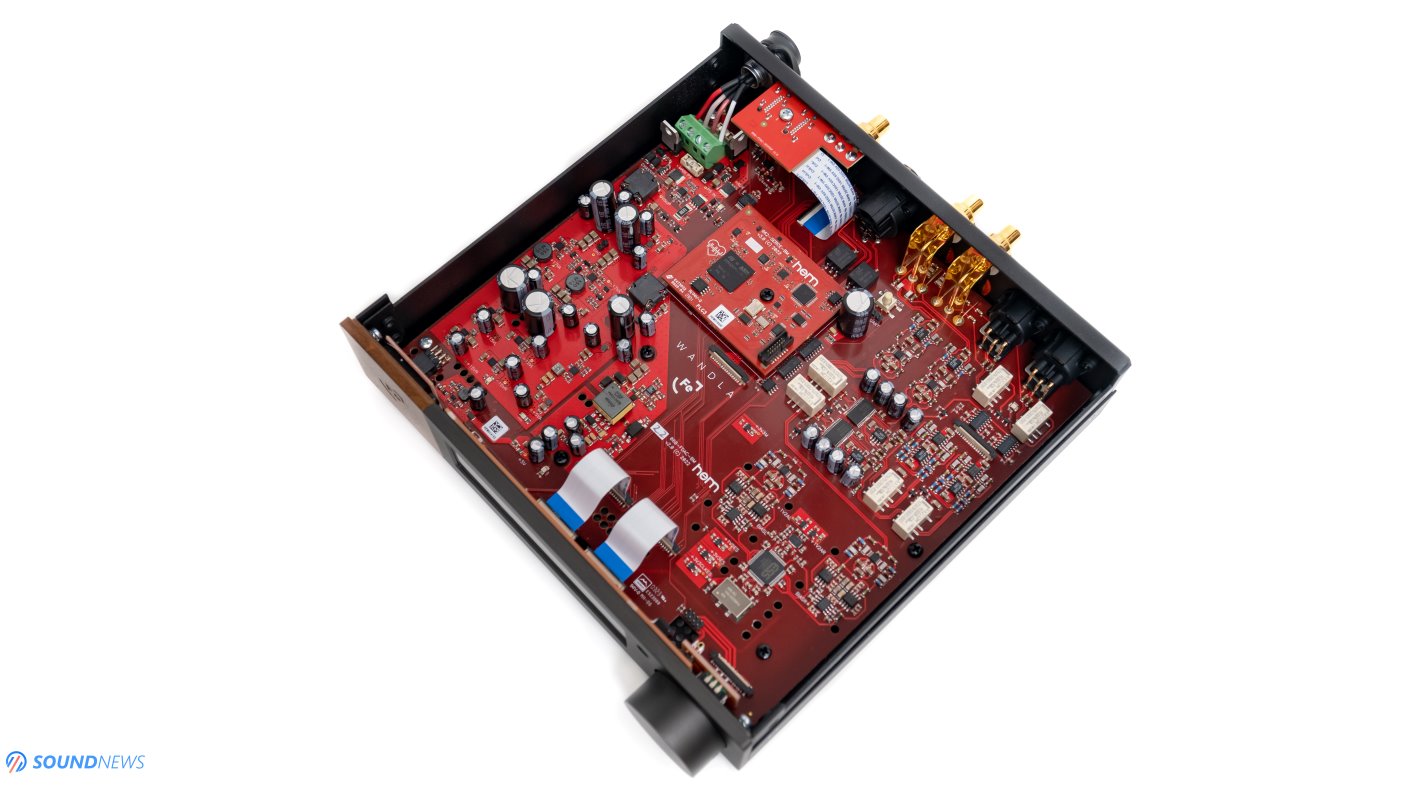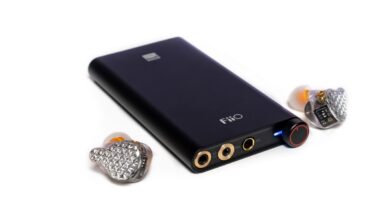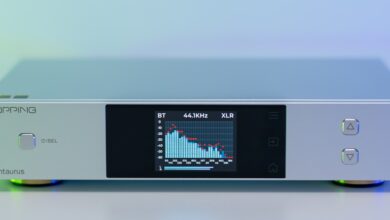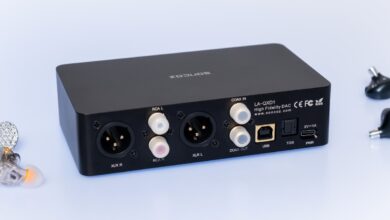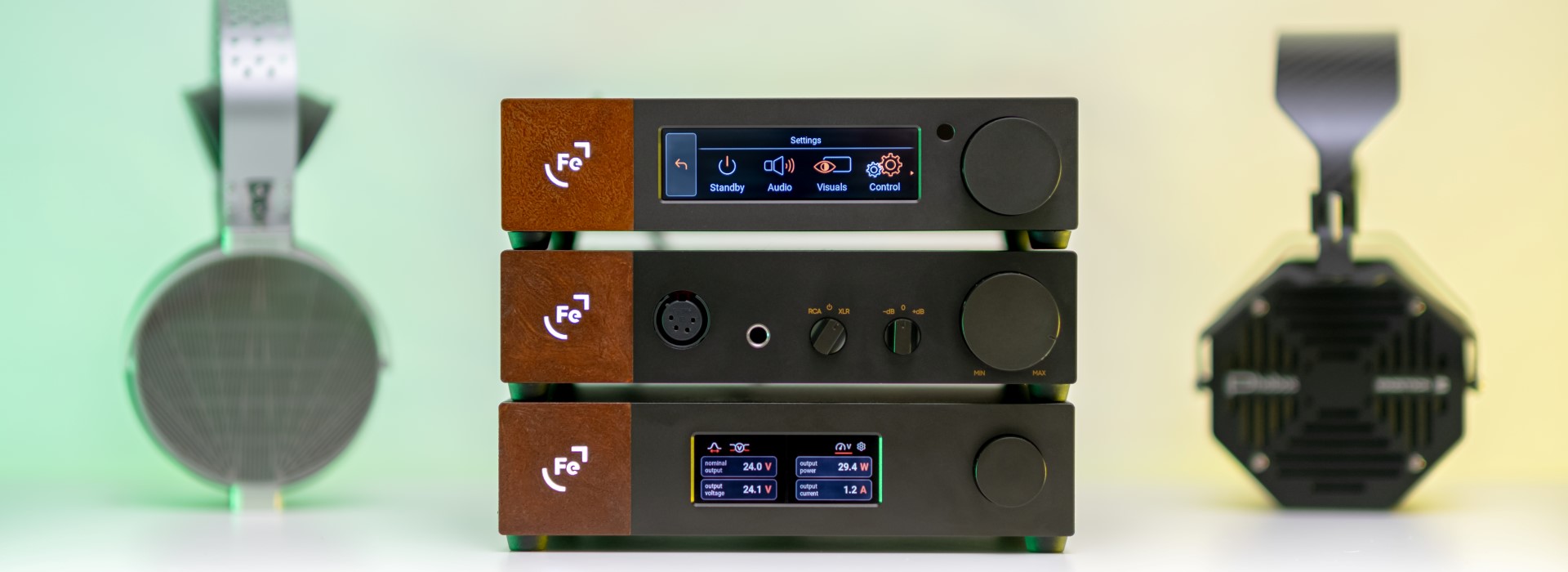
Banding together in 2020, Ferrum Audio might appear young and inexperienced, but their roots are deeper than you might think and their bark is battle-hardened enough throughout the years. Their parent company has more than 20 years of experience doing EMS, ODM and OEM work, offering hardware and software solutions tailored for all things audio. Although Ferrum’s latest WANDLA looks like their first standalone D/A converter, this band of renegades are crafting D/A and A/D converters for quite some time now. As we already learned in our OOR and ERCO reviews, Ferrum Audio loves playing with words. In Latin FERRUM goes for ‘iron’, in Dutch OOR translates to ‘ear’, in Esperanto ERCO is ‘ore’ and in German Wandler goes for ‘converter’ and I have a feeling that Slovak’s Hrdza might be used in a future unit, although I’m not sure any of us can pronounce that word without having a glass of wine in advance.
Ever since their overly powerful, yet natural-sounding OOR powered by HYPSOS landed at our HQ (review here), we started scratching our heads about when a proper DAC will be released by the same manufacturer. Their ERCO DAC/Amp combo (review here) was the middle ground all-in-one unit everybody was waiting for, but people were still hoping that one day an end-game DAC from Ferrum could be placed atop the OOR, for a neat looking head-fi battle station.
We know about the WADLA for more than a year, as these guys are polishing it for quite some time now and I’m glad to announce that it just hit the market. OOR users no longer need to hunt for a matching DAC and Preamp, as WANDLA does exactly that and a little bit more. It might look like a simple, dandy-looking chip-based DAC on the surface, having a pretty cool touchscreen interface, but once you start digging deeper, only then you will realize that except for that DAC chip, everything else was custom built & coded from the ground up. Having a proprietary ARM-based platform called SERCE (heart in Polish) that performs the tasks of five separate chips, the signal path was shortened considerably optimizing the workflow of its digital inputs. The real show-stopper was teaming up with the makers of HQ Player developing custom digital filters and then giving users a choice of coding their own filters! This feature was called DDF or Dynamic Digital Filtering which can be changed on the fly for a custom-tailored sound according to your needs. WANDLA is also a preamp, it can work with the included switching mode power supply or with the HYPSOS for increased dynamics. WANDLA isn’t your regular converter as it wants to be remembered as a no-compromise, chip-based converter that didn’t follow the rules. It goes for €2.795 and you can enhance its performance by getting a smarter HYPSOS power supply for an extra €1195. We will be testing it with and without the HYPSOS in both a headphone and stereo rig and until that happens, let’s unbox it and see what’s inside that package.
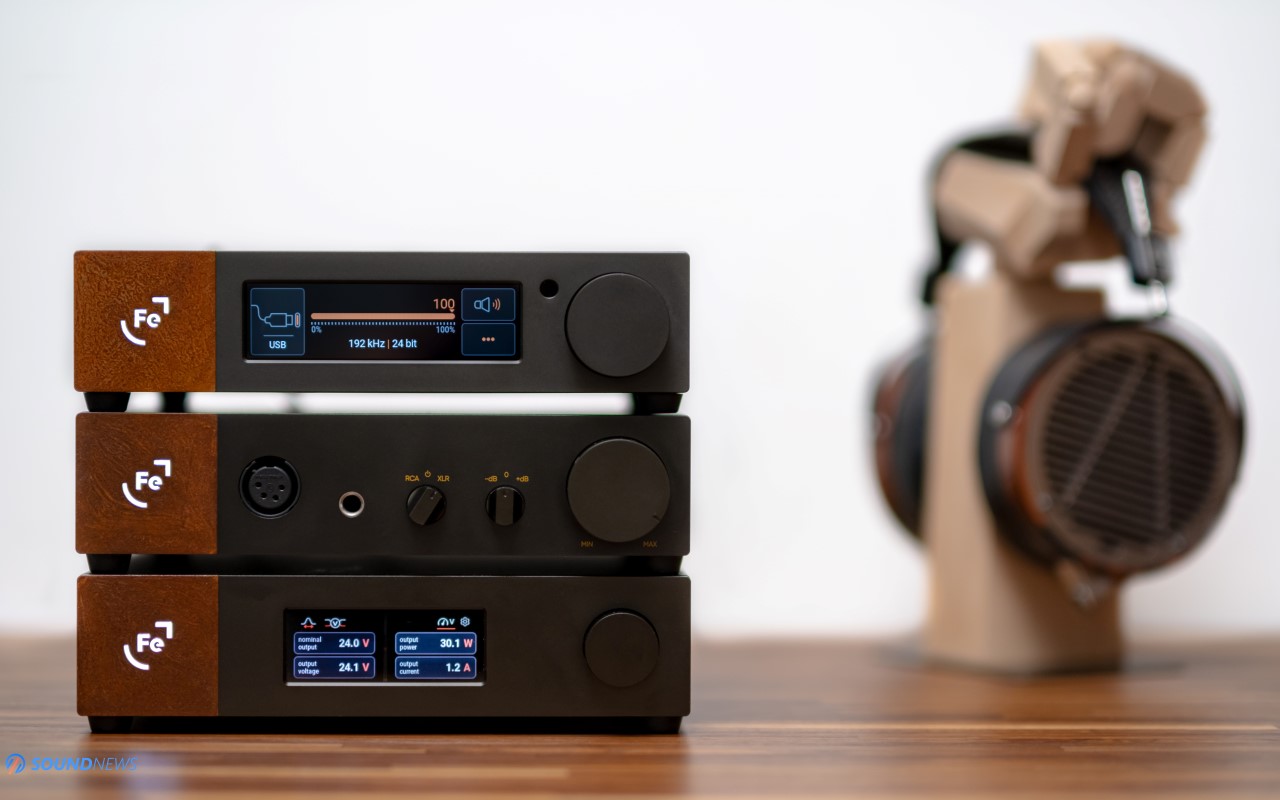
Unboxing Experience
WANDLA arrived double-boxed with a lot of hard foam for better protection during shipping. There’s an impressively detailed Quick Start Guide that will explain down to the smallest details all its inputs, outputs, and use cases. Inside the box, you’ll find the unit itself, a 60-watt switching mode power supply, a power cable, a USB Type-C cable, and a surprise! A remote control. Although ERCO and OOR could be used as preamplifiers, they lacked a remote control to be used properly in a stereo setup, which is no longer the case with the WANDLA. You won’t find a user manual in there, which should save a few trees in the long run, and in case you need it, you can download it freely from here.
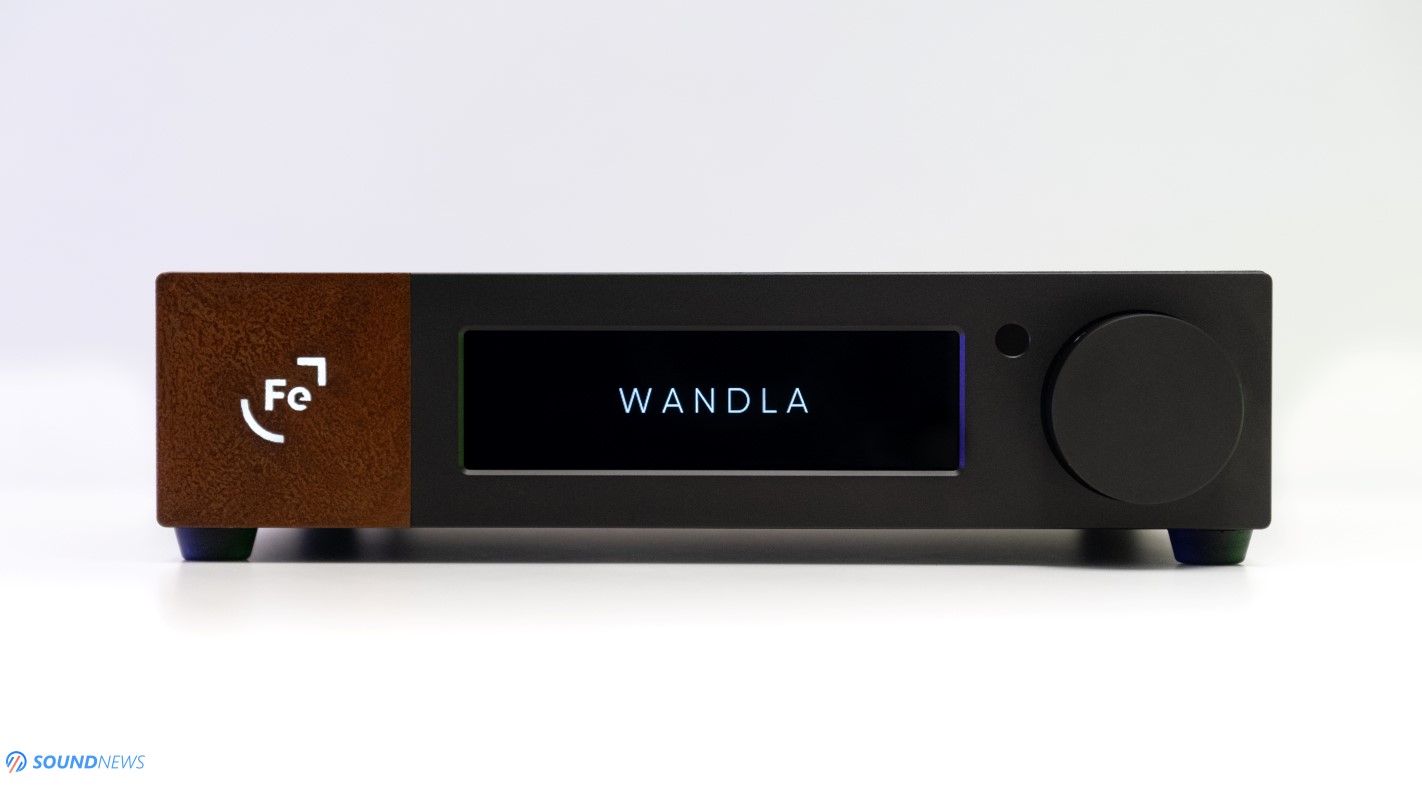
Design & Build Quality
I’ll get straight to the point: WANDLA looks, feels, and smells exactly like a Ferrum product from a mile away. It has the same size and design language as the rest of their lineup, but you won’t mistake it for OOR or HYPSOS due to a bigger touch screen, which feels like a big quality-of-life improvement, especially for us, stereo heads.
Everything else looks exactly the same and that’s a good thing, as I always liked their sleek and minimalist look. While we’re looking at an oversimplified metallic brick, I still appreciate its minimalist look which has a tremendous WAF attached to it. I still dig its illuminated logo, you can increase or decrease the light output and if it bothers you in late-night listening sessions, then you can turn it off completely. As was the case with OOR and ERCO, its top plate was drilled with hundreds of tiny holes that will move hot air away from its electronics, prolonging its service life. It gets warm after a few minutes of use and I’m recommending leaving it in a well-ventilated area. You can put a Ferrum HYPSOS below it and I recommend leaving the OOR on top as it’s the one that dissipates most of the heat. I used this combo for the most part of this review and I had no issues with heat dissipation in my office. With all that being said, please avoid putting hotter units on top and make sure you’ll never block its ventilation holes.
Its industrial look isn’t attracting a lot of eyes, but when HYPSOS goes underneath it, they will surely attract some. Its front plate has a thickness of around 4mm which is thick enough and you can be sure that external wireless interference wouldn’t pose a problem.
OOR’s massive volume knob was selected, discarding the smaller one found on HYPSOS, providing a decent physical resistance. Everything else is occupied by an ultra-wide touch screen that feels snappy and responsive to any commands. You won’t find a single button on its front plate, nor ugly screws, as everything is controlled by its touchscreen or remote control. Simply put, this is one of the sleekest-looking DACs that I have experienced thus far, oozing a Future-Fi flavor. It offers a small footprint and you can easily integrate it into a near-field, stereo, or head-fi setup. With a net weight of 1.8 kilos or around ~4 lbs., I find it lightweight and easy to maneuver around my desk.
The same tall rubber feet are located underneath that will absorb shocks and tiny vibrations coming from within its electronics, making it work at optimum performance. These are bolted and if you fancy nicer-looking shoes, then you can always swap them with Viablue QTC spikes that are matching its matte-black case. Those will elevate it higher, for better ventilation and for a more badass look.
Ferrum went with the same grainy texture on its case, the logo is perfectly aligned with the rest of the lineup which creates a small-sized cubic of pure audio bliss.
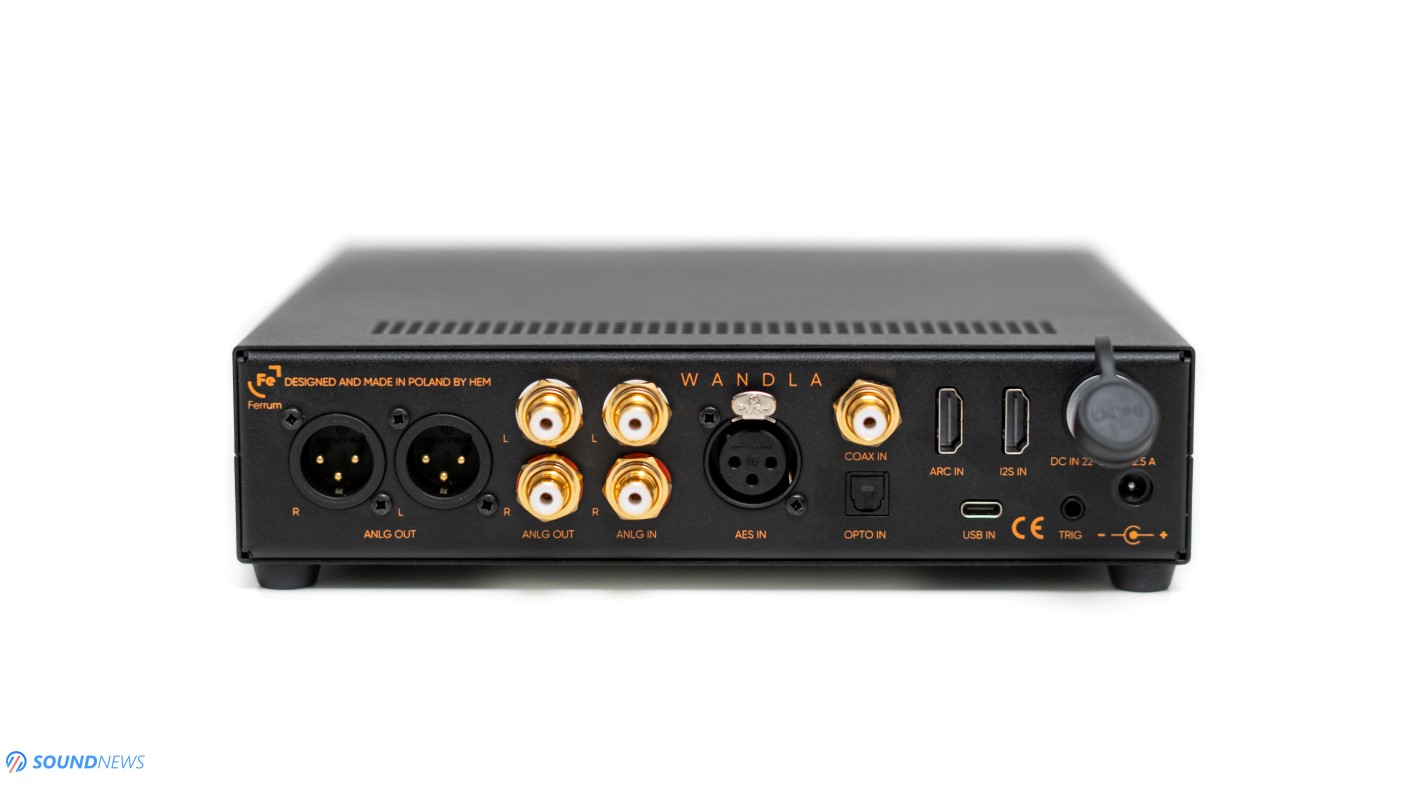
Controls & Connectivity
You can power it with its external switching mode power supply (SMPS) or with a much nicer HYPSOS hybrid power supply, that was specifically tailored to be used with OOR, ERCO and WANDLA. If you already own the OOR and HYPSOS, then please don’t worry, as HYPSOS has enough power for both WANDLA and OOR, just make sure to get a Power Splitter sold separately so it could power them simultaneously.
HYPSOS could bring WANDLA’s performance to new heights and if you need only the best, then HYPSOS feels like a must-have upgrade somewhere down the road. Since we are talking about a smart DAC and preamp, except for a touchscreen and volume knob on its front panel, everything else was moved on its back. There, from left to right you’ll find a pair of XLR and RCA analog outputs to be used as a DAC only or as a DAC and preamp combo. A pair of RCA analog inputs follow, meaning that WANDLA can be used as a dedicated preamp if you please. Six digital inputs are next (AES, Coaxial, Optical, ARC In via HDMI, I2S, and USB Type-C) that will unlock its internal DAC section. Lastly, there’s a Ferrum Power Link 4-pole DC input that connects directly to the HYPSOS and an additional DC input that lets you connect its default switching mode power supply.
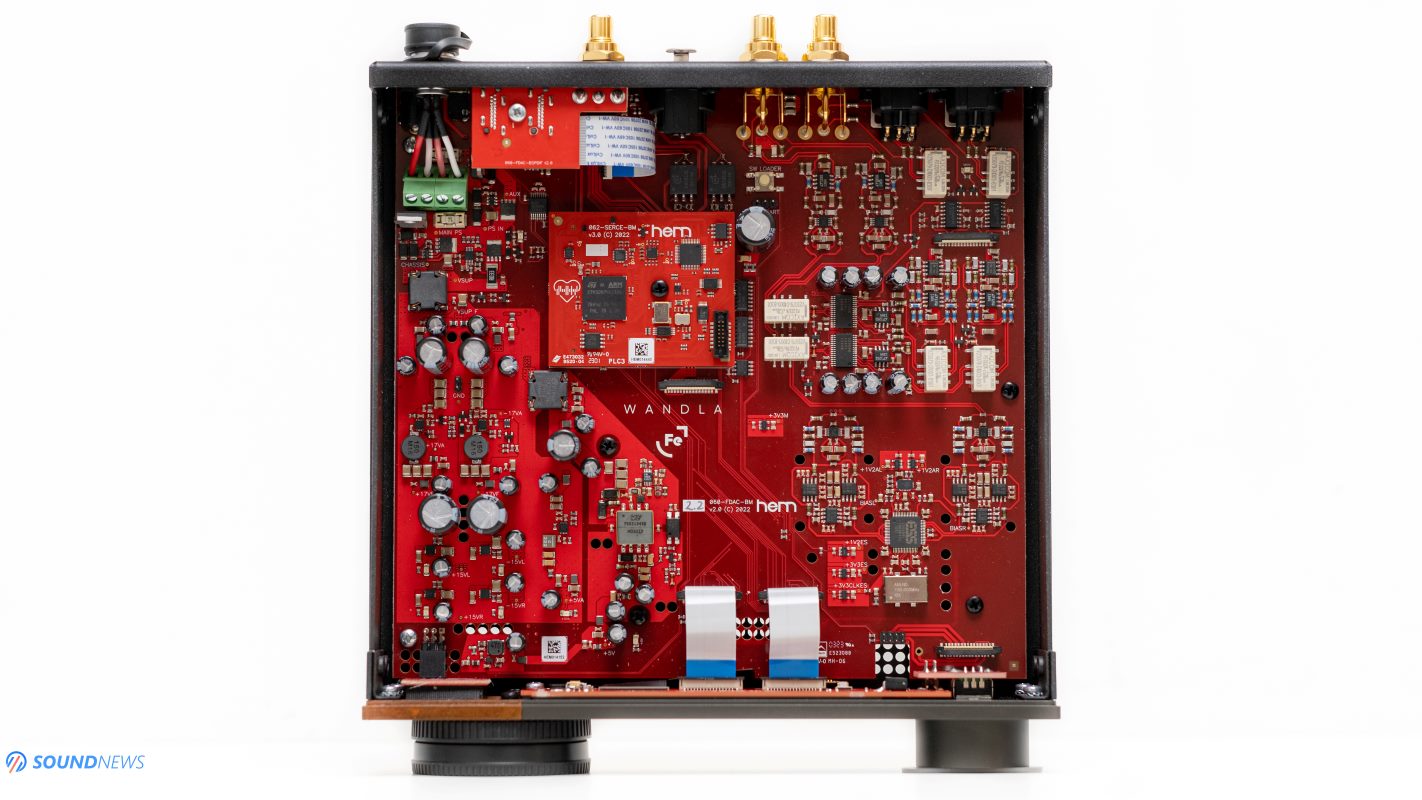
Under The Hood
Following the signal path, you can see that about 1/4 of its internal space is occupied by the power supply, regulation, and filtering stage, but wait a minute. Didn’t I just mention that it can be powered by the included SMPS or by the HYPSOS? Yes, I did, but that is only the first AC to DC power stage and everything that has to do with tinier voltages can be found inside the unit, which I must confess looks impressive.
Going further you can see a small daughter board hovering atop the main board which is called SERCE, which is probably the most important part of the unit. SERCE offers a set of audio-optimized digital inputs that work in unison with a custom-programmed ARM processor. It supports PCM up to 32-bits/768kHz and DSD512 files via USB and I2S, including MQA playback with full decoder and renderer capabilities, it also does DoP decoding and signal level calculation. Two femtosecond clocks can be found on the same board, a Burr Brown S/PDIF chip and the big one is the ARM CPU, which I mentioned above that also deals with the DDF (Dynamic Digital Filtering). WANDLA offers three ESS digital filters to choose from and, as a world first, two digital filters specifically created for Ferrum by renowned filter-maker HQ Player.
Just below the volume knob, you can see a 100 MHz clock, the notorious (and flagship level) ES 9038 PRO DAC chip, and immediately after that, a custom-made I/V (current to voltage) conversion stage follows, as this particular silicon gives a better performance in current output mode. Most D/A converters of this size usually use a single dual op-amp per channel to deal with the I/V stage, but bigger units usually use discrete components that occupy more space and offer better performance. Ferrum went with a very clever hybrid I/V stage designing a composite amplifier that drives the combined current output of paralleled DAC outputs, without adding some distortion of over-driven dual ICs. In short, ES 9038 PRO current outputs are paralleled and then a composite amplifier is converting the current to voltage. This composite amplifier consists of two separate ICs, and the value of resistance in a feedback loop is now four times smaller, as the current flowing through the I/V converter is four times higher. I’ve never seen anything like that in small-sized units and I’m pretty sure this I/V conversion stage will completely alter WANDLA’s voice compared to the regular ESS-Sabre equipped converters.
Finally, a hybrid analog buffer (output) stage follows which again uses separate ICs for all four channels, including a few discrete components and four AXICOM analog relays for a perfect channel balance regardless of the voltage output. Near the RCA inputs, you can spot the preamp section which again uses a hybrid circuit consisting of several ICs and discrete components. I’m very glad that we have a separate output and preamp stage, as usually units of this size don’t have an actual preamp stage inside their cases. I’m pretty sure WANDLA will impress with its preamp capabilities when used with a power amplifier, but more on that a little bit later.
In the end, this is far from your ordinary ESS Sabre DAC. Its power supply implementation, digital processing (including custom digital filters), I/V conversion, buffer and analog preamp stages were built from the ground up and I already see our money’s worth with this unit.

Test Equipment
Ferrum WANDLA is their statement DAC and since we already have the OOR and HYPSOS on our hands, it was mandatory trying them together as a combo and then trying it alone in a stereo setup used as a DAC and then as a DAC and preamp combo.
I will be testing it with and without the HYPSOS power supply which should unlock its maximum potential in both a headphone and stereo setup. Alrighty everybody, my ears are begging for some well-deserved music, so let’s hit some eardrums!
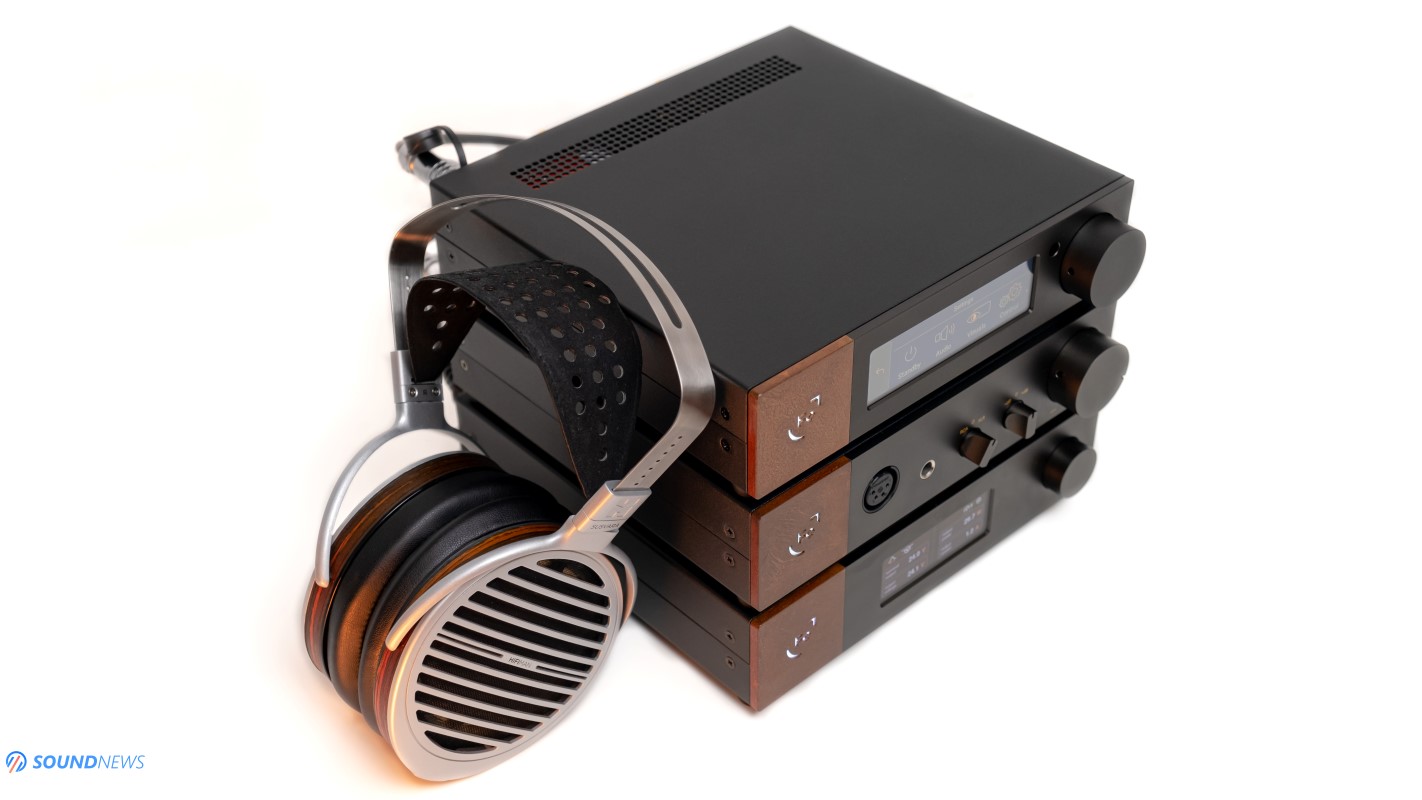
Sound Performance
I. Preliminary Sound Impressions
My all-time favorite metallic boxes to review are digital-to-analog converters, as something always steers my attention to them. I always have a few around the house and I use at least two of them on a daily basis, one in a headphone battle station and another one in a stereo rig. People are usually making preconceptions (myself included) about the performance of a said DAC only by looking at the internal PCB layout and at the components being used, others are making preconceptions only by looking at published measurements and there’s another group that always trusts their hearing abilities. However, the truth often lies somewhere in the middle. There is so much more that doesn’t meet the eye, especially when discussing custom DSPs, digital filters, processing, clocking, FPGA programming, and much more.
When you use off-the-shelf components that are copying their reference boards with little to no coding, then most of these units will sound similar, and we have dozens of examples to prove it. All those affordable units usually coming from Asia which we review on a monthly basis perform very similarly, honestly. Now, if you came here for detailed measurements, sadly, I cannot offer them to you. But if you care how a unit sounds used with actual music, tested for at least a week in both headphone-based and stereo setups, then you’ve definitely come to the right place.
Looking back at all those D/A converters that passed through our hands, the ones that truly impressed us to our core always had teams that were doing custom implementations, like custom I/V stages, custom analog output stages, custom FPGAs infused with their own code, as frankly, polishing a stone into a gemstone requires a considerable time investment. If you peek inside a few D/A converters that cost more than a car, you won’t find components worth ¼ of their asking prices. In many cases, R&D work is considerably more expensive than the internal layout & components.
Audio engineers who think outside the box will deliver a different type of sound and experience. This is why many converters may seem strange to audiophiles at first. Oftentimes for a better sound, new paths need to be paved, as following the usual approach will only lead to the same results as before.
Ten years ago, I didn’t believe in high-end HiFi. However, after experimenting with a few FPGA and R-2R designs, I realized that I was living in a big ignorant bubble. Nowadays, I’m open-minded, I treasure new developments and innovations in the digital and analog domains and I genuinely believe that Ferrum Audio is one of these innovators. WANDLA is not your regular ESS-Sabre DAC. I’m sure many of you see it this way, but after experimenting with more than forty ESS-Sabre equipped units, I’m confident in saying that WANDLA doesn’t perform like any of those.
I must confess that I strongly believe the first impressions a brand-new unit makes on you are the most impactful and, over time, tend to diminish as your brain becomes accustomed to the new sound. That’s why I usually power on new DACs and amplifiers and let them play for at least two days straight before putting my ears to work. Our brains don’t know what to expect from the newest units, so your first impressions are often the most vivid and powerful. I should also confess that, while I consider my stereo setup to be high-end, I always (yes, emphatically) listen to a new DAC connected to an ultra-transparent headphone amplifier and ultra-resolving set of headphones. This approach completely bypasses room acoustics. I can hear significant differences between two DACs in a well-thought-out headphone setup, and my impressions are often less vivid in a stereo rig, as room acoustics may interfere significantly.
Besides being known as the DAC-Man, close friends are also calling me the Gin-Father, so I sat down, made myself a gin-tonic, and commenced a long listening session via WANDLA, OOR, HYPSOS, and Hifiman Susvara. The very first impressions I got were that the sound is incredibly cursive, like a fluid passing through my ear canals. The sound was pouring slowly and gradually in a very effortless way, a sensation that I had never experienced with ESS-Sabre units before. A Rockna Wavedream Signature sitting nearby has the same liquidity and refinement, which is not surprising given its price. The surprise is that the smaller WANDLA could match that level of smoothness at just a fraction of Rockna’s price.
The legendary-sounding Sonar just released Three Movements on steaming platforms (Qobuz / Tidal), and I was eager to give it a listen via WANDLA. Only a few seconds in and a subterranean bass note hit my eardrums with incredible power. The sounds felt weighty and full-bodied, more so than any other ESS-Sabre equipped unit I tried before, even more so than Gustard’s excellent-sounding X26 PRO. I was taken aback, as the X26 PRO was considerably bigger and scarier looking, yet the WANDLA could sustain longer bass notes and provide more air mass in the lowest octaves.
When I switched back and forth between the WANDLA and a few less impressive ESS-Sabre DACs, I noticed that the volume and dynamics increased substantially with the WANDLA. Hifiman Susvara usually needs a scary-looking amplifier to awaken their fullest potential, but a simple DAC swap made the Susvaras considerably livelier and punchier sounding. After some research, it appears that the 9.3V output from WANDLA’s XLR output boosts the power of the amplifier that follows, compared to an industry-standard 4V output. OOR and HYPSOS were already mighty impressive with the Susvara on a regular 4V output DAC, but with the WANDLA, I simply have more power on tap coming from the OOR. The difference was, to put it mildly, significant.
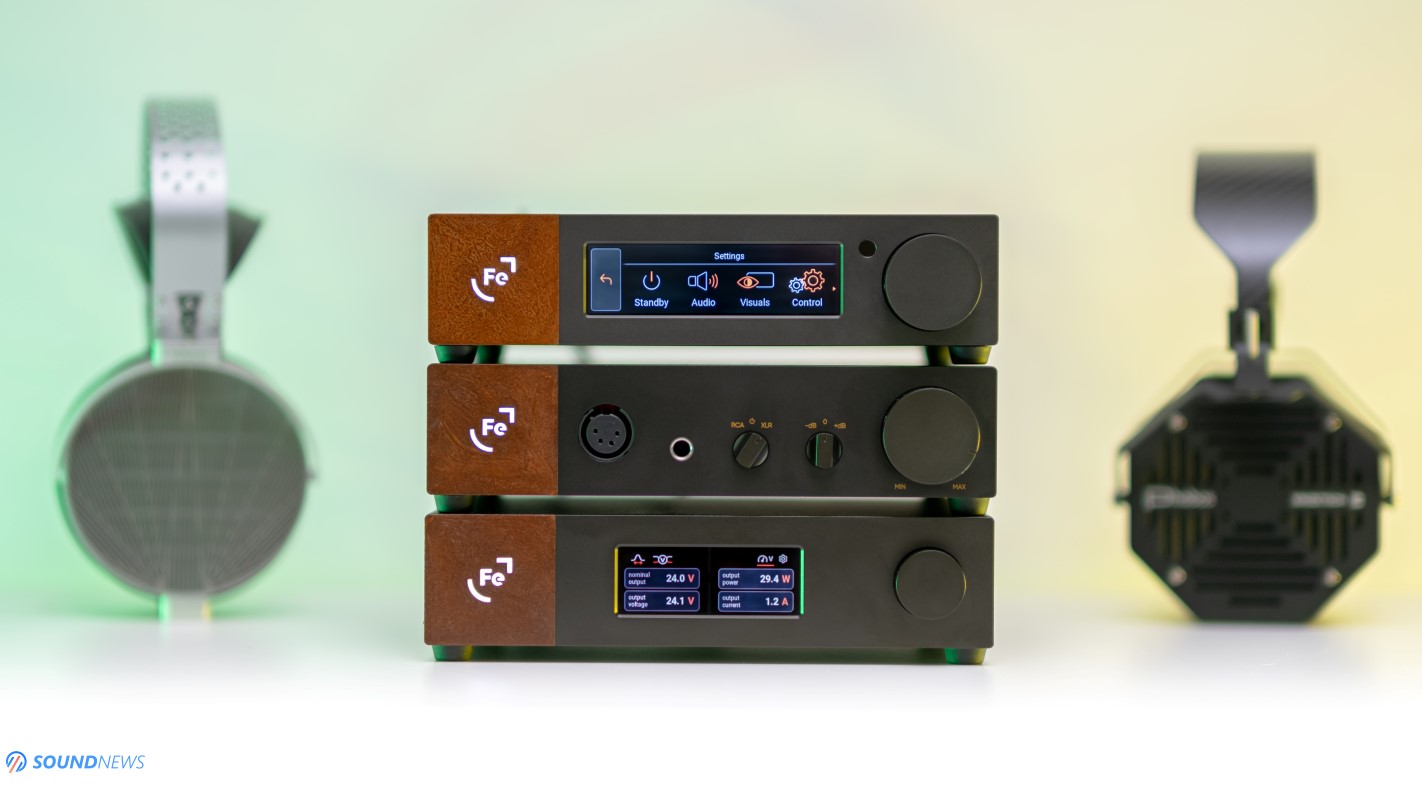
II. To HYPSOS, or not to HYPSOS, that is the Question
If you’ve followed our Ferrum OOR and then ERCO reviews, then you already know the benefits HYPSOS was bringing along, especially in homes where electricity isn’t filtered and/or preconditioned. When we moved to this place,the first thing I did was replacing every single wire from the wall, with thicker OFC wire of a higher purity. The entire electrical grid was replaced with a new one and I made sure that my office and living room would use dedicated power lines that wouldn’t interfere with the rest of the house. Although costly as hell, it substantially improved my listening experience.
HYPSOS is not your usual transformer-based power supply, but more like a hybrid power supply that uses a switching mode PS in the first stage that cleans up the mess for the next stage which uses a linear transformer for a healthier current delivery. Hybrid power supplies are becoming increasingly popular, as I started seeing them in a lot of units, from Gold Note PSU-10 EVO, to Musician Aquarius and Denafrips Gaia and many others are embracing such designs.
I didn’t include a noise floor chapter in this review, as with or without the HYPSOS, connected to the wall or to any of my passive power conditioners (Plixir BAC1500 & KECES IQRP-1500), WANDLA didn’t show an increase or decrease of perceived noise when using speakers or headphones. The DC filtering sitting inside the unit is already impressive at cleaning up the mess, so don’t expect to hear a clearer signal, although that might happen if your power lines are messed up. Unsurprisingly, the HYPSOS did exactly what it already did to OOR and ERCO before it, infusing a bit more life and making the music jumpier and more engaging. The difference wasn’t massive I’ll give you that, but I cannot deny getting nicer dynamics as if the amplifier was pumping more power into my headphones. Bass notes were even thicker and the crescendo moments were bringing more emotions forward. WANDLA never felt fuzzy or out of focus on its own, but HYPSOS did improve the stereo image and I could easier point out the location of the notes. In one way or another, transparency improved to a small degree, additional micro-details took center stage and on top of that what was already a fun sound signature, transformed into a dopamine-dosing machine, sounding livelier than ever before.
If you already own the OOR and you’re thinking about getting the WANDLA, then HYPSOS becomes a must-have upgrade down the road, but if you are only intending on getting the WANDLA, then HYPSOS feels like a possible upgrade, but if your pockets are deep enough, then you can get them both for maximum performance.
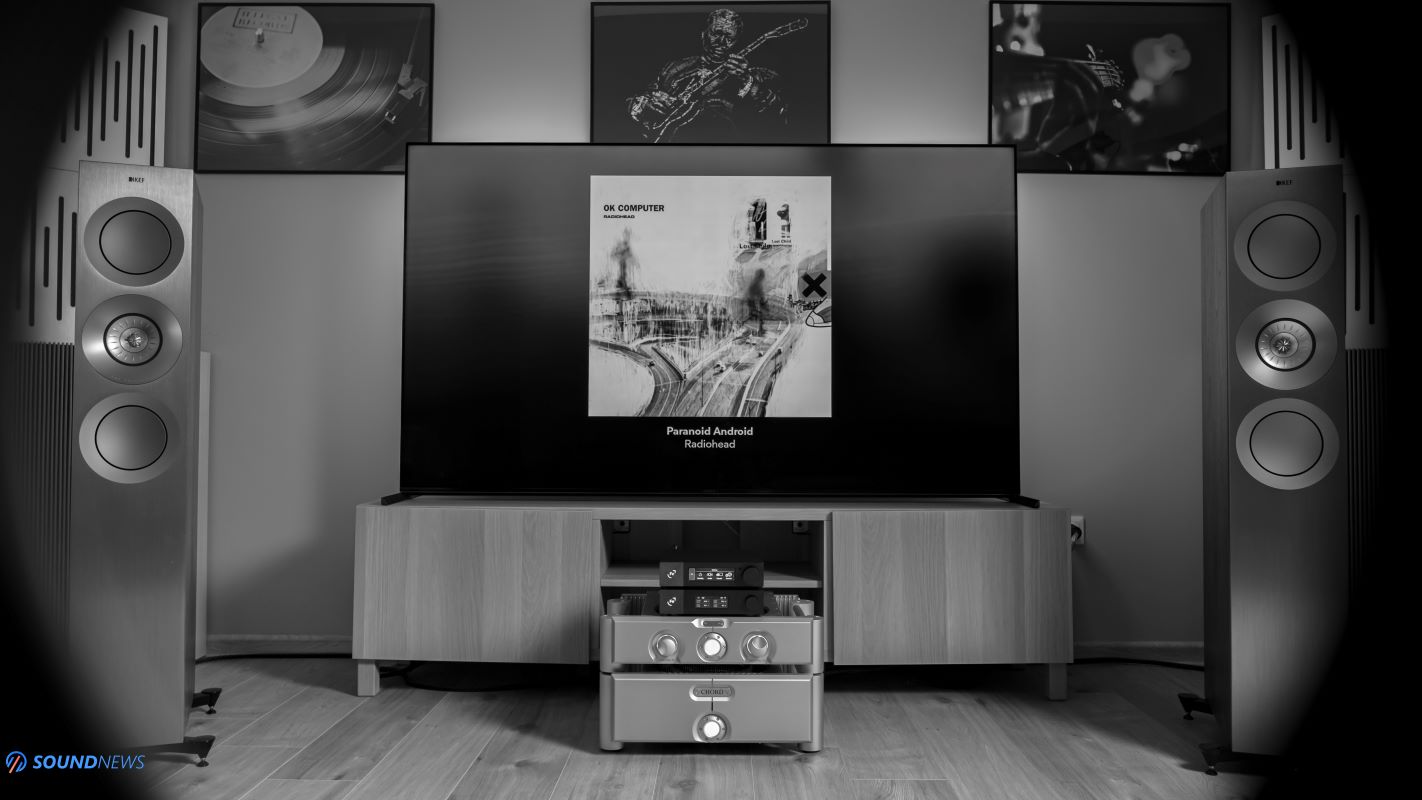
III. Transient Response & Dynamics
If you are a headphone listener and if you already own the Ferrum OOR and a few low-sensitivity headphones like Hifiman Susvara, Abyss AB-1266 Phi TC, DCA Expanse, or Stealth, then WANDLA becomes a must-have upgrade to the DAC you’re currently using.
With a 9.3V output at full power, WANDLA empowers the output stage of the amplifier that follows, meaning that you will be getting more power from the OOR (or from any other amp) without even touching the volume knob. I went ahead and connected it to a few desktop headphone amplifiers, some were affordable and some were end-game material, but all of them benefited from a higher voltage intake. A70 PRO by Topping is already a decent amplifier for Susvara owners on the cheap, but with the WANDLA taking the place of D70 PRO, I kid you not that the sound got weightier, fuller, much stronger, and you could feel that with regular music not only with Hi-Res recordings. As I was swapping it with a few more DACs, it was clear to me that WANDLA is a dynamics monster and no matter what you do, it will always leave a mark on the final performance.
It’s really redundant writing about speed in an ESS-Sabre equipped DAC, these were and still are the fastest sounding chip-based units out there, but the real showstopper right now is not the speed that everyone expected, but the raw bass slam that hits you like a choo-choo train. Some headphones from my collection need a helping hand when trying to awaken those deep rumbling bass notes and a sane person will always do that with some sort of EQ or amplifier swap. I don’t EQ much, meaning that I will always be swapping amplifiers if I want a more fun sound signature. The fun part is that the WANDLA made a bigger difference than when I was swapping op-amp-based amplifiers with fully-discrete Class-A ones. It infused more energy down low and I was no longer seeking a Class-A amplifier to be added into the chain. WANDLA sounded fantastic even with a Topping A70 PRO with a pair of Hifiman Susvara sitting on my head, never longing for the OOR or for any other fully-discrete amplifier.
The party started when I added the OOR and HYPSOS into the mix, my wife could hear my laughing from a mile away when the music started playing, as I don’t remember getting so much fun out of solid-state electronics. This triple wombo-combo is no longer a soulless stack, but a must-hear system that you owe yourself to try at audio shows.
The crazy dynamics, depth, and sound density coming out of this combo need to be heard to be believed. If you’re here for the fun times, for wild smiles and giggles, then I cannot think of a better combo right now. It’s redundant explaining to you how it sounded via rock or electronic music, for me a few tracks put more logs on the fire forgetting to write for a few hours, as clearly, powerful dynamics are part of Ferrum’s DNA.

IV. Soundstage & Imaging
There was another strong impression that was tingling my thoughts in the first minutes of use, and that was the depth and note separation, which aren’t something to write home about in a chip-based unit. Most delta-sigma designs I used try to impress the listener with a big picture thrown in front and to the sides. However, what really differentiates a great-sounding DAC from a world-class sounding one is not the stage size, but the separation of the notes on the Z axis, or the so-called layering and depth. I purchased my end-game DACs, especially the Wavedream Signature, mostly because it creates a speaker-like experience via headphones. The note separation is so extreme, that sometimes it feels like listening to a near-field stereo setup, or like binaural recordings replaced your entire stereo collection. Wavedream Signature is always like that, and that is its strongest skill, always creating a 3D map inside your head. When it comes to chip-based D/S converters, sincerely maybe 2 or 3 of them were providing good depth and note separation. Gustard A26 has a decent depth and separation, Matrix Element X was quite good at that as well, but what Ferrum achieved with their WANDLA is nothing short of spectacular.
I always felt that the OOR, together with HYPSOS, had an out-of-head soundstage, but when it came to depth, I felt that Trafomatic’s Primavera was on another level, putting a higher accent on the notes playing in the background. In some ways, WANDLA isn’t trying to portray a bigger picture, but it definitely tries to add additional sound layers, creating a much better separation between the soloist and the rest of the band.
I usually listen to Lucky Peterson on my stereo rig, which can place the sounds all around me, with the soloist taking center stage, and the drumming right behind him. Via headphones, there’s too much information to my right and left and way too little in the middle. Compared to a regular ESS-Sabre DAC, WANDLA is linking the left and right sound bubbles, putting more music in the center and adding more layering to it. My blues and jazz tunes start having a new meaning with WANDLA and I’m no longer pressed to use my stereo setup for a goose-bump fiesta.
Today, I won’t say much about its sound staging capabilities as I think they are excellent, something that can be done by a unit half the price of the WANDLA like Gustard’s A26. Today is all about the depth and strong imaging that WANDLA is doing so well. Having a strong separation of layers was always a troubling aspect via headphones, but this unit solves the biggest issue I had via headphones. I no longer need to stress myself or close my eyes to walk around my tunes, it becomes so much easier and that’s something you will rarely get with a D/S unit. Its custom-built I/V conversion stage is playing a massive role here, freeing the limitations put in place by off-the-shelf designs used by cheaper alternatives. Add custom digital filters that will give all the warmth and sweetness and slowly you start realizing that WANDLA does not sound like your regular D/S DAC. I started contemplating if I still need Chord’s DAVE as frankly, WANDLA gives me a similar sound (subjectively speaking) and performance at a way more attractive price.
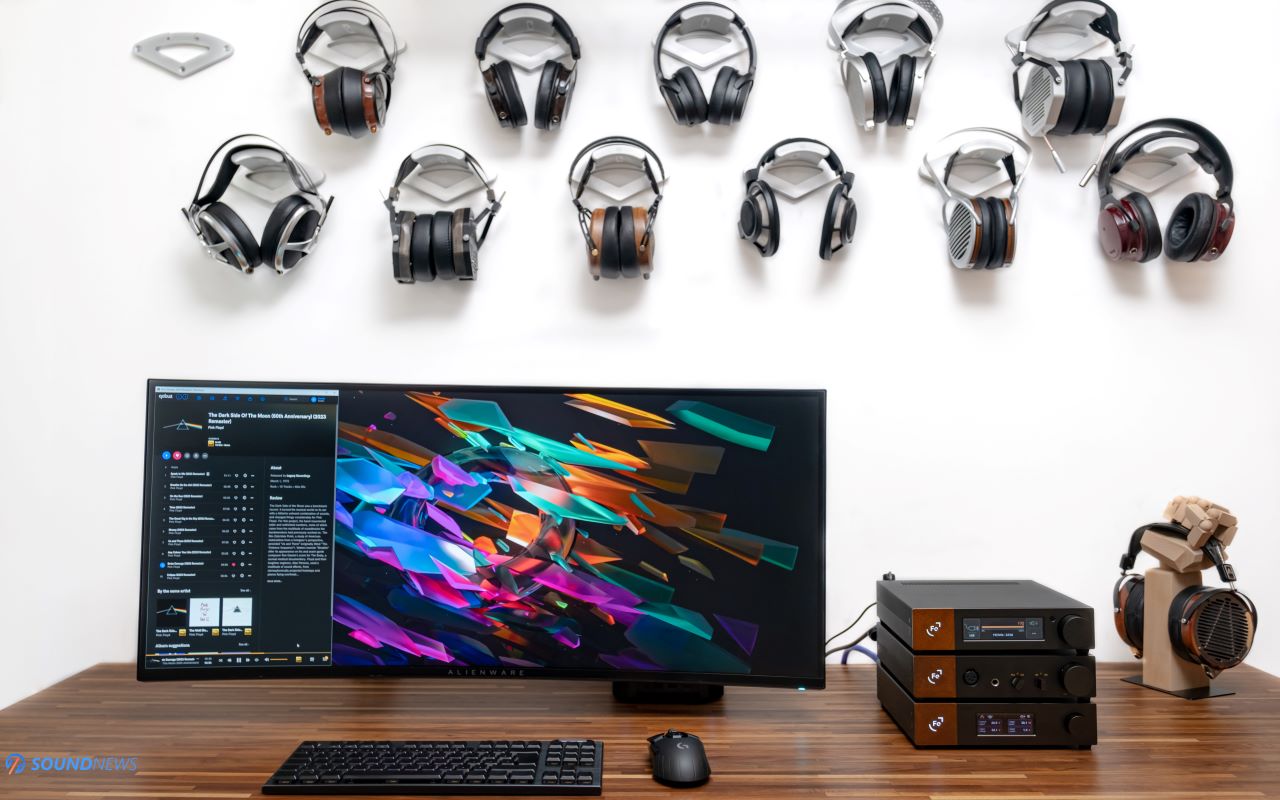
V. Detail Retrieval & Transparency
Most ESS-Sabre converters, even the ones that cost less than a pair of decent interconnect cables, have already mastered the art of extracting as much information as possible and pushing that to the amplifier that follows. I’ve encountered all kinds of D/A converters over the years, but foggy and unresolving ones that carry ESS silicon have never come up.
Obviously, our ears can only marginally understand signal-to-noise ratio, but we can all agree that once a converter sounds clean and transparent to its core, then it’s close to impossible to go back to a less resolving one. The mere fact that I’m considering replacing the Chord DAVE with Ferrum’s WANDLA should hint at a few things regarding its resolving abilities. Again, I won’t rely on its measured performance, but on subjective listening impressions through a pair of resolving speakers and equally impressive headphones. The way it brings information forward is quite interesting. It does all of this in a very nonchalant way, like sipping from a cocktail on a Mediterranean beach. It does it naturally and easily without flexing its muscles. My usual playlists and Hi-Res tunes were repeating the same words over and over again, suggesting that I’m dealing with a clean and highly resolving unit.
What impressed me, however, wasn’t its sheer detail retrieval and resolving abilities…but the way everything is presented to the listener. It’s one thing getting a highly resolving, but ultimately dry and uninvolving sound and it’s something else entirely getting the same resolution, in a very vivid and organic way. If you ever experienced an FPGA DAC before, from the likes of Chord Electronics, dCS, Audiobyte or others, then you know exactly what I’m talking about. You aren’t buying an Audiobyte or dCS for their resolving abilities, although that is still a very important aspect, you are buying such units for their naturalness, lucidity, organic textures, and smoothness, and that’s what I’m getting from the WANDLA as well.
I don’t think I ever called an ESS-Sabre DAC as smooth or liquid-sounding, but WANDLA browses through my music with such ease, I feel that system matching is no longer needed. I put it on two integrated amplifiers, then on two power amplifiers, and then on several headphone amplifiers, and I was always getting that excellent separation of layers filled with sounds to excess.
People sometimes associate chip-based D/S designs with clean, highly resolving but ultimately soulless and dry-sounding D/A converters. If you look around, you will rarely find such designs in high-end audio applications, with only a handful of exceptions to this rule (Mola Mola Tambaqui, Weiss DAC501 & 502). That description fits perfectly several entry to mid-level D/S designs, but WANDLA isn’t part of that group. It’s mostly full-bodied, hard-slamming, punchy, and weighty sounding, without altering the frequency response. It’s magnificent sounding in the treble, extracting intricacies without piercing my eardrums with hundreds of invisible needles. In my view, WANDLA is a detailed-sounding machine and it’s a very transparent-sounding one as well. The only thing it doesn’t do well is rendering razor-sharp leading edges, which aren’t as outlined as it usually happens on the regular ESS-Sabre units, but if you like some of that, then I suggest disabling HQ Gauss or HQ Apodizing filters and enabling an ESS filter from those available, which felt sharper sounding to me.
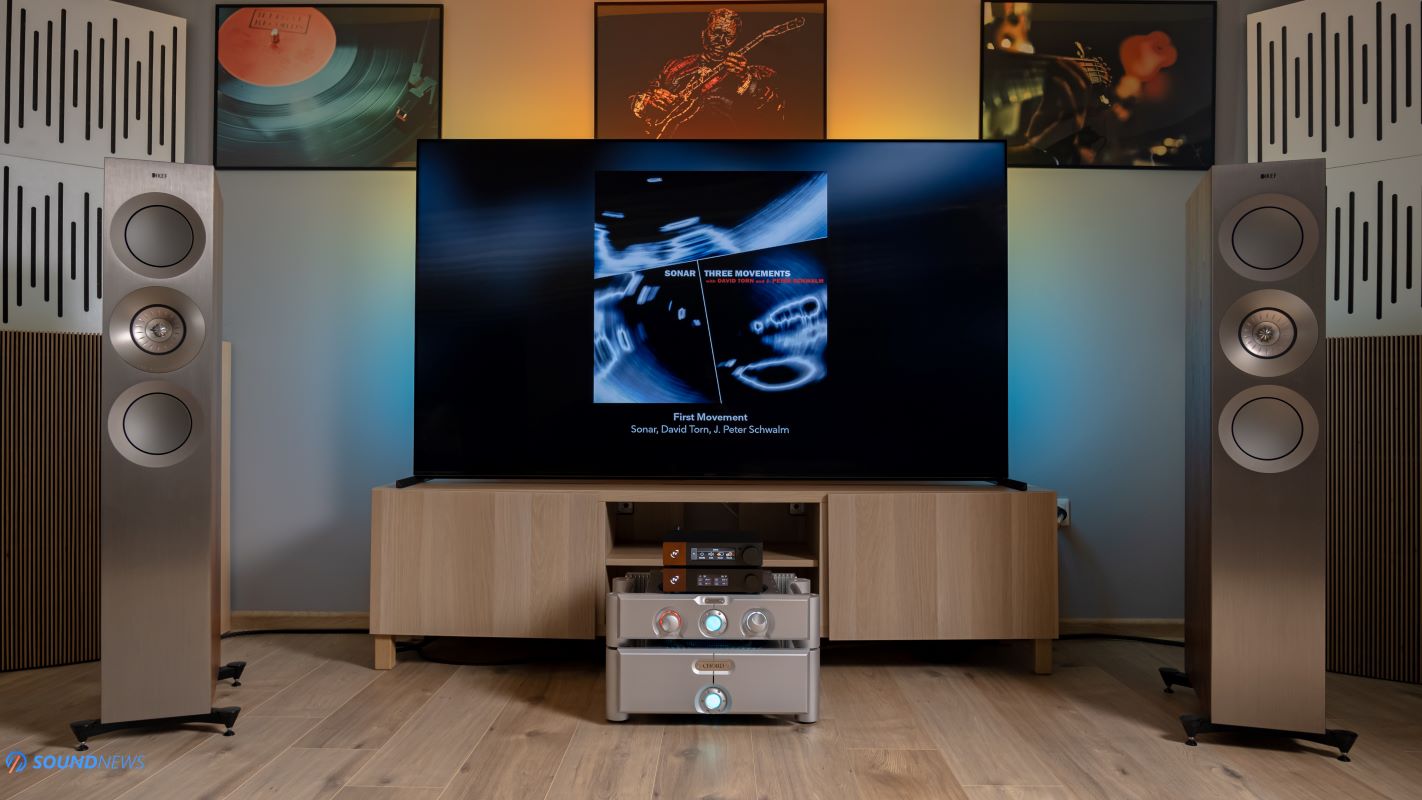
VI. Ferrum WANDLA in a Stereo Setup
We already know how WANDLA behaves in a headphone rig, and I’ve explained why I’m using headphones. After testing a plethora of D/A converters in the comfort of my home, I observed a fascinating phenomenon when I used the built-in preamp of said converters, instead of using an active and dedicated preamplifier.
If you use an integrated amplifier, you may skip the next phrases. However, if you are using power amplifiers as I do, then please read on. Most D/A converters don’t have an actual active preamplifier stage and most of them don’t have an analog volume control, instead going with a digital one that’s more precise at the cost of a lower dynamic range as you start attenuating that signal.
As the price escalates, their I/V stages become more ingenious and sometimes an active preamp stage could be spotted, like in the Matrix Element X2 ($4400) that can exceed the industry standard 4V output. Such units will sound considerably bolder with your power amplifiers, the stage won’t be limited in size, the depth won’t get hurt, but most importantly, dynamics won’t get crushed. There is a reason I used the Element X for more than two years and the Gold Note DS-10 Plus for almost two years as well. They weren’t limiting dynamics, and the sounds never felt 2D or plain boring.
Ferrum didn’t go with a time-tested solution, they developed their own I/V conversion stage specifically tailored for the ES 9038 PRO silicon, designing a composite amplifier, and using separate converters for each output channel. This approach doesn’t overwhelm the ICs with tons of current that could generate additional distortion. Apart from this, a dedicated analog preamp stage is also present. Interestingly, Ferrum decided to go with a much hotter output of 9.3V via XLR and 4.65V via RCA which, in my experience, has a beneficial effect on the power amplifier that follows. So, how does WANDLA behave as a DAC and Preamp combo in a stereo setup?
It performed marvelously! And I never felt that Chord’s Ultima 3 Pre needed to go in between it and the Ultima 5 power. It sounded more impressive as a DAC + Pre compared to Gustard’s R26 and A26, considerably better compared to any Topping or SMSL unit, and I dare to say even better than Matrix’s best converter yet. The depth and separation I was getting could easily challenge the very best units that passed through my hands. There was meat on the bone, the sound was weighty, wide and tall, filling every corner of the room. WANDLA behaved so impressively as a preamp that Ferrum felt a separate analog input was mandatory, and if you need that, it can work solely as a preamplifier. This speaks volumes about the confidence they have in their creation.
My all-time favorite Radiohead album is OK Computer (Qobuz / Tidal) which left a big mark on my adolescent life. Back in the day, I was exchanging cassettes with the cool kids on the block. Nirvana and Pearl Jam were everywhere, but I was seeking a different kind of sound and experience. I bought OK Computer out of curiosity and remember giving it a listen with my dad who was into Beatles, Led Zeppelin, Queen, and a little bit of Pink Floyd. From the first track, Airbag, I knew that these guys had that ‘something’ I was seeking to differentiate myself from the Nirvana heads. I re-listened to the whole album three times on the first day, and with every listen, my appreciation grew stronger. I know this album so well that four tracks are part of my daily listening routine. I know every note of Airbag, Paranoid Android, Karma Police and No Surprises. Hearing them on the WANDLA felt like a trip down memory lane. These tracks are about alienation, loneliness, paranoia, and a host of other things. I loved the album at first listen, having a profound impact on my early life. WANDLA not only revived those feelings but also made everything clearer and more vivid, like looking through a window at a younger version of myself. The recording and mastering are simply spectacular, easily among the top-5 best-recorded rock albums of all time, and WANDLA amplified the best parts of this album. What was supposed to be a 20-minute listen transformed into a two-hour marathon, as I couldn’t skip the other tracks, plus KID A was still awaiting its turn. Once you hear Radiohead on the WANDLA, it’s close to impossible to turn down the music, be it at 14:00 midday or 02:00 o’clock midnight, it will have this effect on you.
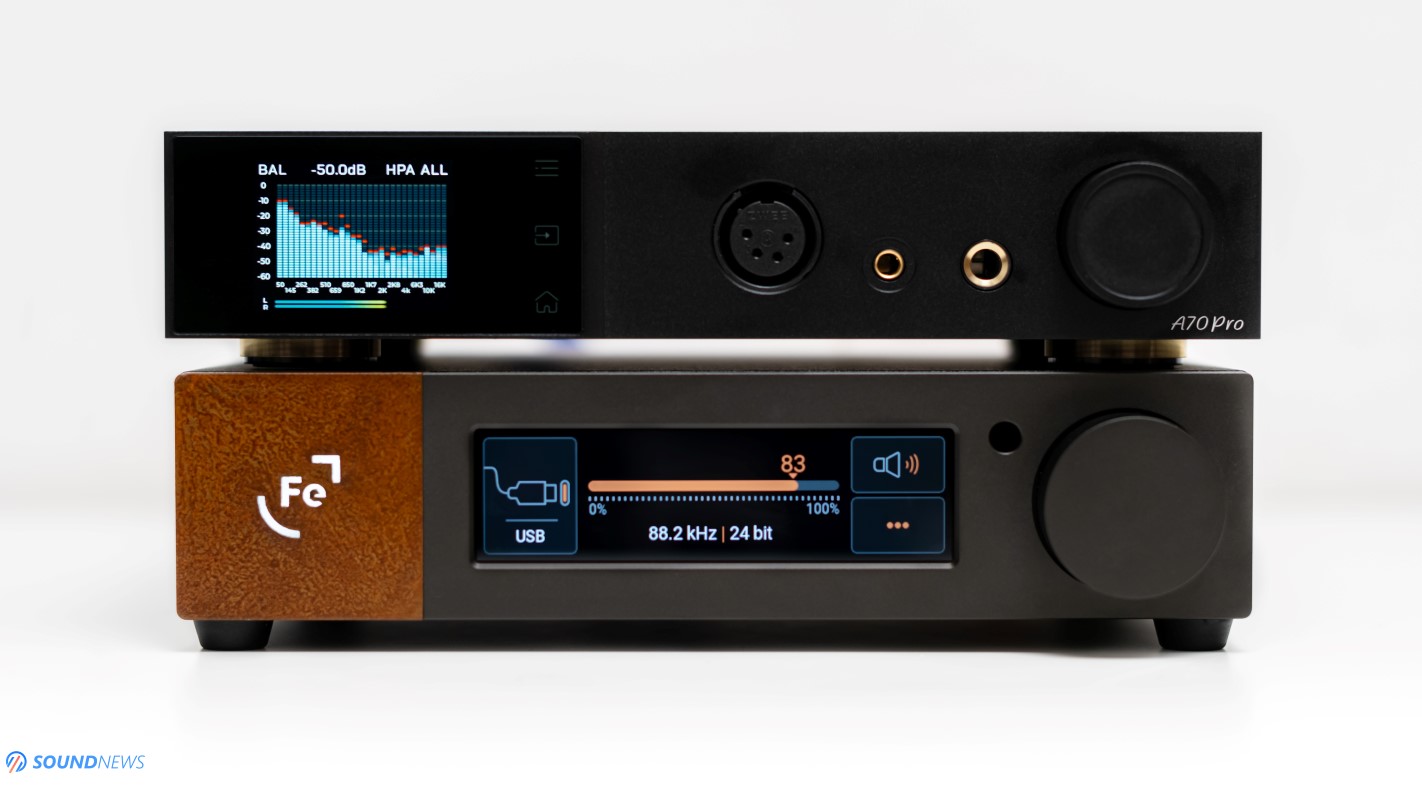
Frequency Response
VII. Bass
Ferrum’s WANDLA does bass texture, weight, and sound pressure level more impressively than most units that have passed through my hands, except for Rockna’s Wavedream Signature which is even more impressive. Wait a second, even weightier and punchier than Chord’s DAVE? That’s exactly what my ears are hearing. The bass is strong in this one, not only when it comes to texture but also in terms of weight and kick. When you move from the USB connection to the I2S connection with the help of a DDC (digital-to-digital converter) like Singxer SU-6, or with the help of a music server/wireless streamer that offers an I2S output, then you’re in for a Big surprise. Rockna’s Wavedream NET can work as a music server for 3rd party DACs and in no time, I was already cursing loudly in Polish. From an outstanding bass performance on the USB connection, I’ve got a tremendous boost in bass layering via I2S! Even the tiniest air movements in a live recording became much easier to spot, additional bass layers were unlocked as well, there was more silence and more music all around me. I’m comfortable mentioning that if you really like the bass from the bottom of your heart, then WANDLA is the perfect candidate regardless of the digital input being used. It’s always so juicy, full-bodied, and powerful that it will be changing the nature of your speakers and headphones without the need for an amplifier swap. WANDLA and OOR working as a team have quite possibly the nicest bass performance I experience from solid-state electronics, absolutely yummy sounding!
VIII. Midrange
People usually mention a dry, uninvolving, and boring midrange on ESS Sabre powered units. You will read about this everywhere online, from forums to media outlets, people genuinely think that if you like a natural midrange then you should steer away from such units. As Ferrum and many other tinkerers around the world have proved so many times, that’s only the prologue of a much bigger story. Everything you see in the WANDLA is custom-built except for the ESS silicon. The DSP, I/V, analog buffer and analog input stages are all custom, tailored for this particular silicon. The end result? The most organic and smooth sounding ESS-Sabre based converter that I have experienced thus far. The midrange is full-bodied and weighty and so refined at the same time. Everything that has to do with vocals sounded real, emotionally attaching me to the singer. There was more meat on the bone and texture even compared to pricier converters like DAVE for example, so much so that I rediscovered my love for soprano vocals once again. The change is quite drastic and even linear sounding amplifiers will carry over those traits to your speakers or headphones. I am burning in the Topping D70 PRO and A70 PRO combo and I was curious how A70 PRO would sound with a different DAC that is powered by the same silicon. I was shocked by how different D70 PRO and WANDLA sounded. One was ultra-linear but ultimately thin sounding and the other was making a 180-degree turn. One sounds just fine and the other revitalizes my music and puts more energy where there is none. WANDLA will forever change your preconceptions regarding DAC chips that you’ve been building for years…sounding truer to life to the point of disappearing from your acoustic chain.
IX. Treble
When you are taking away all the digitus, the grain, the glare, and the sharpness, everything that remains is a natural representation of the frequency response. Forget about such things, they aren’t dwelling inside WANDLA’s case, instead, you will be thinking about how beautiful everything dances around your ears. The trebles are clean and extended, you’ll easily be hearing nuances and intricacies, but those won’t try to steal your attention as usually, sharp sounding DACs are doing. WANDLA keeps on giving tons of warmth and smoothness, but without hurting the extension or the cleanliness of the sound. It sounds so inviting that sometimes I’m wondering if a small vacuum tube was hidden somewhere behind its display or PCB board, there’s something that compels you to add more music to your playlist. For people like me, this unit is both a curse and a blessing. Once music starts playing, I’m throwing my keyboard away. I’m no longer having tunnel vision, I’m no longer engaging a magnifying glass hearing, I’m just reclining my chair, getting immersed into the music. What should be a 3-day writing marathon transformed into 5 days of writing. It’s also a blessing, especially if you listen to music for more than two hours a day, as it will never induce listening fatigue. On the contrary, it knows how to relax your senses and calm your spirits. Its treble was never sharp, or super-outlined, forget about tiresome leading edges, those are no longer a concern with a unit like this on your table.
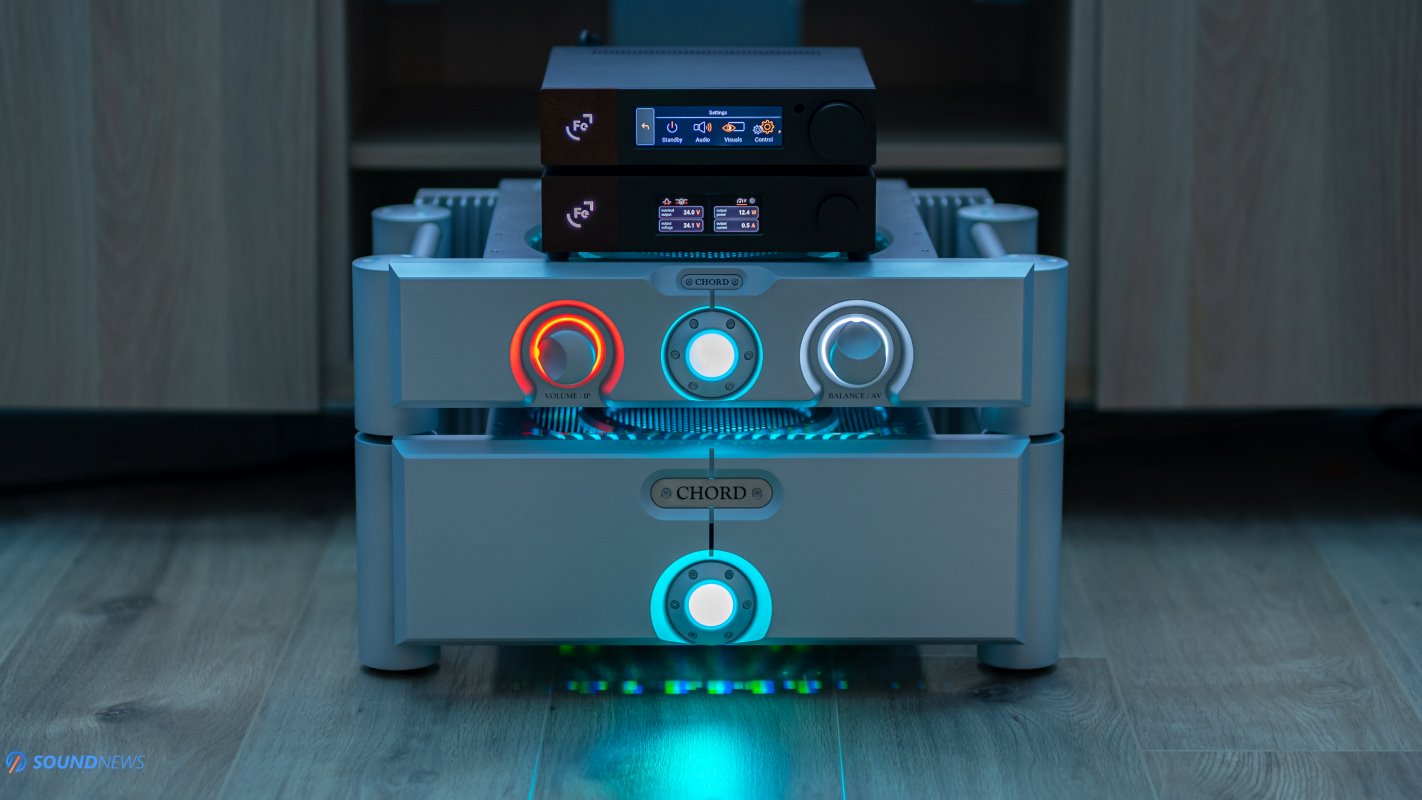
My Conclusions
Plato once said: “Music gives a soul to the universe, wings to the mind, flight to the imagination, and life to everything”. I couldn’t put it better. For me, music is an escape from a simple mundane life. Often, I don’t have time for a full-featured film to start laughing out loud or crying like a baby, but thanks to music I can feel alive in just a matter of seconds. In the digital world we live in, you need a D/A converter that will be swapping zeroes and ones with sound waves, and then a transducer to hear all that goodness. You already have such converters all around you: in your phones, tablets, PCs, TVs, radios, and many other devices. However, the ones that convert bits of information into genuine human emotions are usually dedicated D/A converters, and that’s how I discovered my love for them.
Can you love a metallic box? You can’t, but you can appreciate the team behind it, the philosophy and the thinking behind such a unit. Ferrum’s WANDLA is far from an ordinary converter and that was felt from the very first minute I pressed play. I must confess that when something excites me to the core, I usually share preliminary impressions with my closest friends. Some have already been bombarded with WANDLA’s impressions, as those feelings were strong and I couldn’t keep them all to myself.
I have a question for you, yes…You! How do you measure if a D/A converter is worth its asking price? Do you look at internal components and start doing a BOM via Farnell or Mouser? Do you take into consideration the R&D time, and the size of the team, or are you just listening to the damn thing and draw your own conclusions?
I’m curious about your answer, but I take into account all that and maybe a bit more. This industry isn’t moving millions of DACs sold; people still don’t care that much for perfect sonics, and proof is the hundreds of millions of consumer-grade wireless headphones sold every year. As for me, I’m glad companies like Ferrum exist today, not only from a business perspective. WANDLA wasn’t made in a month and it won’t be replaced the next year. Ferrum never cherished those ideas; it will be here to stay for a very long time. Its custom I/V and buffer stage bypassed the need for a dedicated preamplifier. The digital filters are (finally) sounding so different from each other compared to those I usually test on competitor units, and I don’t need to remind you how it sounds as a DAC-only unit. I was skeptical at first that such a small unit could dethrone bigger and pricier units, but once I started reading about it and checking its inner workings, I immediately realized that this is not your regular live-fast-die-young converter coming from the East. WANDLA is about the music…and the emotions attached to it. It’s here for the fun times, and if you’re already thinking of getting one, then prepare to be converted by the real thing.

The highest award we have right now is the Golden Award, but as we’re slowly transitioning to Soundnews 2.0 (you probably saw by now all the new categories and additional features), we will be adding a higher tier in the near future, which I feel Ferrum’s team fully deserved. A Gold Award will suffice for now for the hard work involved, and ultimately, for the performance you are getting in return. You can get it for €2.795 or for €3.990 together with the HYPSOS directly from their web store. I don’t think that’s a fair price; I think that’s a bargain knowing how it performed in both a stereo and headphone setup.
In case you are getting one, please let me know in the comments section below, and don’t forget to press that Subscribe button on YouTube, it means a lot to me. That’s all for now, Sandu’s signing out!
PROS:
- Minimalist industrial design, forming a great looking stack with the HYPSOS and OOR
- Rock-solid build quality, working great in tight spaces
- Amazing I/O options, big and neat looking touchscreen
- It’s not just a smart DAC, but an outstanding Preamp as well
- Those digital filters finally sound so different
- Resolving and clean sounding, without adding an over-sharpness filter
- Outstanding tonal balance, leaning towards warmth and naturalness
- Rich, lush and smooth sounding for the most part
- A fast transients & punchy dynamics monster DAC!
- Forget its wide soundstage and excellent imaging, the depth and separation were epic
- Sounds unrestrained, effortless and easy-going
- Extended frequency response at both ends
- Noiseless performance in both a headphone and stereo setup
- Lacks listening fatigue and any forms of brightness
- Fun and engaging sounding at all times
- Punches above its asking price
CONS:
- Sounds better via HYPSOS, sorry for your wallet
- Display’s viewing angles are limited due to a TN panel (instead of an IPS, VA or OLED)
ASSOCIATED EQUIPMENT:
- DACs: Ferrum WANDLA, Chord Electronics DAVE, Rockna Wavedream Signature XLR, Gold Note DS-10 PLUS & PSU-10 EVO
- Wireless Streamer & Music Server: Rockna Wavedream NET 4TB, EverSolo DMP-A6
- DDCs: Singxer SU-6, Matrix X-SPDIF 3
- Headphone Amps: Ferrum OOR & HYPSOS, Trafomatic Primavera, Enleum AMP-23R, Burson Soloist 3X GT, Flux Lab Acoustics Volot
- IEMs: Westone Mach 50, Meze Rai Penta, FiiO FH9 & FX15, 7Hz Timeless AE, Kinera Skuld & others
- Full-sized headphones: Meze Elite & 109 PRO, Erzetich Charybdis & Phobos V.2021, HiFiMan Susvara & HE1000SE, Audeze LCD-5 & LCD-4, Sennheiser HD800S, Kennerton Rognir (planar) & Vali, Apos Caspian, Sendy Peacock & Apollo, HarmonicDyne Elite & Poseidon, others
- Preamps: Chord Electronics Ultima 3 Pre
- Power Amps: Chord Electronics Ultima 5 Power, Burson Timekeeper 3X GT (x2)
- Loudspeakers: KEF Reference 3, Musician Knight 1, Sound of Eden Crescendo UNO
- DAC/Amps: Shanling H7, FiiO Q7, Topping G5
- DAPs: FiiO M15S, M17, Shanling M7, Hiby R6 PRO II
- Interconnects: Crystal Cable Reference2 Diamond (x3), QED Reference (x2), Topping TCX1 (x2)
- USB Cables: Supra USB Excalibur (x2), Chord C-USB, Matrix Hi-Fi USB
- HDMI Cables: Audioquest Diamond DBS, Supra 8K HDMI
- Speaker cables: Kimber PR8, Audioquest Type4
- Power Cables: Crystal Cable Reference2 Diamond (x3), Isotek EVO3 Premier (x2), iFi Audio SupaNova (x2)
- Balanced Isolation Power Conditioners: PLiXiR Elite BAC1500 (stereo setup), KECES IQRP-1500 and P14 (headphone setup)
